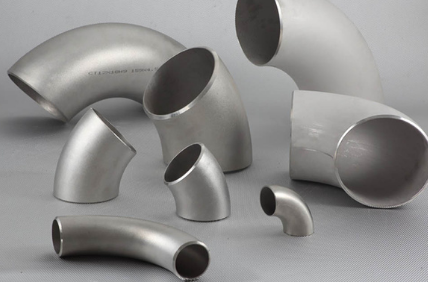304L stainless steel buttweld fittings are essential components in industries where durability, corrosion resistance, and strength are vital. Known for its low carbon content, 304L stainless steel is a variant of 304 that offers specific benefits in applications requiring welding. This blog covers the unique properties, types, benefits, and applications of 304L stainless steel buttweld fittings.
What Are 304L Stainless Steel Buttweld Fittings?
304L stainless steel buttweld fittings are used to connect, change the direction of, or control the flow within pipelines by creating strong, seamless joints. They’re common in industries requiring reliable, leak-proof connections. The “304L” designation refers to a low-carbon variant of 304 stainless steel, which helps prevent carbide precipitation during welding—a significant benefit for weldable applications.
Properties of 304L Stainless Steel Buttweld Fittings
- Corrosion Resistance: High chromium and nickel content in 304L provides excellent corrosion resistance against moisture, chemicals, and most acids, making it ideal for harsh environments.
- Low Carbon Content: The reduced carbon level prevents carbide precipitation, reducing the risk of intergranular corrosion when exposed to high temperatures during welding.
- Strength and Durability: 304L combines strength and flexibility, making it reliable for long-term use.
- Non-Magnetic in Annealed State: 304L fittings are typically non-magnetic in the annealed condition, advantageous for applications requiring non-magnetic materials.
Types of 304L Stainless Steel Buttweld Fittings
304L buttweld fittings come in various forms to meet diverse pipeline needs:
- Elbows: Used to change flow direction, available in 45° and 90° angles.
- Tees: Allow branching of pipelines into multiple directions.
- Reducers: Connect pipes of different diameters to change flow rates or pressure.
- Caps: Seal pipeline ends for temporary or permanent closure.
- Crosses: Enable four-way intersections for flow control.
Each type serves specific pipeline functions, adding flexibility to design and functionality.
Benefits of Using 304L Stainless Steel Buttweld Fittings
- Weldability: The low carbon content minimizes carbide precipitation during welding, preventing corrosion along the weld seam.
- Temperature Resistance: 304L withstands temperature fluctuations, making it suitable for both cryogenic and high-temperature applications.
- Cost-Effective: Durable and affordable, 304L is an economical choice compared to other stainless steels with similar properties.
- Minimal Maintenance: Corrosion resistance reduces maintenance needs, saving time and resources.
- Aesthetic Finish: 304L has a clean, polished appearance, ideal for visible piping systems in commercial settings.
Applications of 304L Stainless Steel Buttweld Fittings
304L buttweld fittings serve a wide range of industries, including:
- Food and Beverage: Non-toxic and corrosion-resistant, 304L is ideal for food-grade applications where cleanliness is critical.
- Pharmaceuticals: Meets stringent hygiene standards, is easy to clean, and resistant to contamination.
- Chemical Processing: Stands up to corrosive chemicals and acids, ideal for aggressive environments.
- Petrochemical and Oil & Gas: Handles the corrosive, high-pressure conditions common in refineries and plants.
- Water Treatment: Durable and rust-resistant, ideal for continuous water contact.
304L vs. 304 Stainless Steel Buttweld Fittings
Although 304 and 304L share similar compositions, they differ primarily in carbon content:
- 304: Slightly higher carbon content can increase hardness but raises the risk of carbide precipitation along weld seams.
- 304L: Lower carbon content reduces carbide precipitation risk, making it ideal for welding where corrosion resistance is crucial along the weld seam.
-
What is 304L Stainless Steel?
304L stainless steel is a low-carbon variant of 304 stainless steel, which is part of the austenitic family of stainless steels. This particular alloy contains:
- 18% chromium
- 8% nickel
- A maximum of 0.03% carbon
The lower carbon content in 304L helps minimize the risk of carbide precipitation during welding, making it particularly advantageous in applications requiring welding or exposure to high temperatures.
Standards and Specifications
304L stainless steel buttweld fittings conform to various standards that ensure quality, strength, and performance, including:
- ASTM A403
- ASME B16.9
- ANSI B16.28
These standards govern dimensions, pressure ratings, and wall thickness, ensuring safety and functionality.
Conclusion
304L stainless steel buttweld fittings are a dependable and versatile choice for industries requiring durability, corrosion resistance, and temperature tolerance. Their low carbon content makes them ideal for welded applications, ensuring a corrosion-resistant, durable solution for various piping systems. At Munot Metollys, we specialize in providing high-quality 304L buttweld fittings that meet industry needs with reliability and cost-effectiveness.When it comes to piping systems in various industries, the choice of materials and fittings is crucial for ensuring longevity, safety, and efficiency. One of the most widely used materials for such applications is 304L stainless steel, particularly for buttweld fittings. In this blog, we’ll delve into the properties, advantages, applications, and key considerations of 304L stainless steel buttweld fittings.











